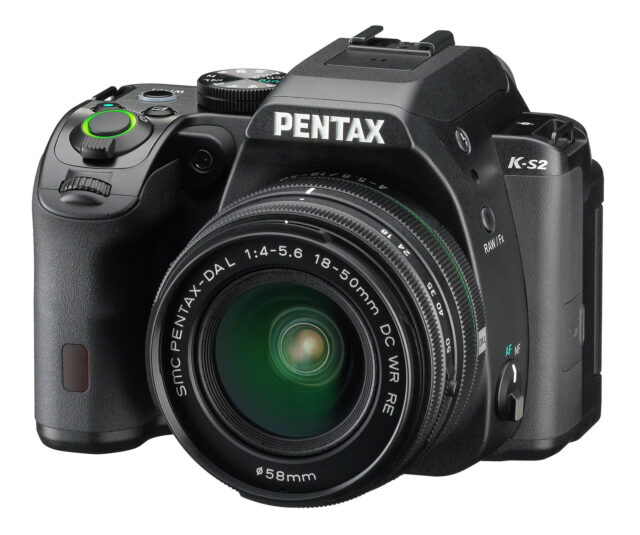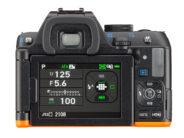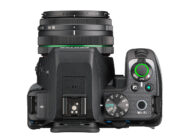Announced
Production status
System
Pentax K APS-C system cameras
- Pentax *ist D
- Pentax *ist DL
- Pentax *ist DL2
- Pentax *ist DS
- Pentax *ist DS2
- Pentax K-3
- Pentax K-3 II
- Pentax K-3 III
- Pentax K-3 III Monochrome
- Pentax K-30
- Pentax K-5
- Pentax K-5 II
- Pentax K-5 IIs
- Pentax K-50
- Pentax K-500
- Pentax K-7
- Pentax K-70
- Pentax K-m
- Pentax K-r
- Pentax K-S1
- Pentax K-S2
- Pentax K-x
- Pentax K100D
- Pentax K100D Super
- Pentax K10D
- Pentax K110D
- Pentax K200D
- Pentax K20D
- Pentax KF
- Pentax KP
Pentax K-S2
APS-C AF digital SLR camera • Discontinued
Specification
| Format: | |
| APS-C | |
Imaging sensor: | 23.5 × 15.6mm CMOS sensor |
Resolution: | 5472 × 3648 - 20 MP |
Crop factor: | 1.53x |
Sensor-shift image stabilization: | Yes |
| Pentax K [45.5mm] | |
| Shutter: | |
Type: | Focal-plane |
Model: | Electronically controlled |
Speeds: | 30 - 1/6000 + B |
| Exposure: | |
Exposure metering: | Through-the-lens (TTL), open-aperture |
Exposure modes: | Programmed Auto |
| Aperture-priority Auto | |
| Shutter-priority Auto | |
| Manual | |
| Physical characteristics: | |
Weight: | 618g |
Dimensions: | 122.5x91x72.5mm |
Manufacturer description
Meet the PENTAX K-S2 – the small digital SLR camera that packs a punch! Providing outstanding imaging performance to rival high-end models and incorporating a wide range of features to cover every eventuality, all packed in a compact, dustproof, weather-resistant body with a variable-angle LCD monitor.
The latest camera to join the ranks, this new upper-class model, is the world’s smallest dustproof, weather-resistant digital SLR camera* designed for active, outdoor shooting. In addition to the PENTAX-original SAFOX X autofocus system, which performs superbly with poorly illuminated and moving subjects, it provides a full range of advanced features, including: an AA (anti-aliasing) filter simulator to assure the same level of moiré-reduction effect as an optical AA filter; an optical viewfinder with a glass pentaprism to provide a nearly 100% field of view; an in-body shake reduction mechanism; and a top sensitivity of ISO 51200.
It also provides remote shooting functions and wireless LAN and NFC functions - for the first time in the PENTAX K series - to make it easier to pair with smartphones and tablets.
The K-S2 LCD monitor also features a variable-angle design for the first time in a PENTAX digital SLR camera. By rotating the monitor 180 degrees to face the subject, the user can activate the self-portrait shutter button, to capture the perfect selfie!
This model comes in a range of three main body colors: black, white and black & orange. And as with other models in the range also offers the PENTAX colour order service with a choice of seven additional colour options in two outdoor-themed collections: three in the Field Collection, and four in the Sports Collection.
To accompany the K-S2 RICOH IMAGING has also developed the smc PENTAX-DA L 18-50mm F4-5.6 DC WR RE standard zoom lens as an exclusive kit lens. This weather-resistant lens features a retractable mechanism to make it compact and portable without sacrificing optical performance. By pairing this lens with the compact K-S2 camera body, users are guaranteed a highly portable digital imaging system that performs brilliantly.
Main Features
1. The world’s smallest dustproof, weather-resistant body*: The K-S2 camera body is not only designed to be compact and portable, but also dustproof and weather-resistant. One hundred seals have been applied to crucial parts of the body to prevent the intrusion of rain and dust into the interior, making the K-S2 a perfect choice for a wide range of outdoor activities, including mountain climbing and camping. Included in its lens kits is a super-compact zoom lens, with a length of just 41mm in the stored position despite its weather-resistant construction. The combination of the K-S2 camera body and this lens creates a highly portable digital imaging system.
2. Variable-angle LCD monitor for easy image viewing: The K-S2 comes equipped with an Air Gapless LCD monitor, which has a special resin layer applied between the protective panel and the LCD screen to effectively cut down the reflection and dispersion of light and assure excellent visibility. This monitor also features a variable-angle design for the first time in a PENTAX digital SLR camera, allowing the user to set the monitor to the desired viewing angle and simplify high- and low-angle shootings. By rotating the monitor 180 degrees to face the subject, the user can activate the self-portrait shutter button, which is provided in addition to the regular shutter-release button, to keep a firm hold of the camera when shooting self portraits (or selfies!).
3. High-precision autofocus system with SAFOX X module: The K-S2 features the state-of-the-art SAFOX X AF sensor module, which assures responsive, high-precision autofocus operation. With its 11 sensors including nine cross-type sensors in the middle, this AF system assures pinpoint focus on a subject at a minimum brightness level of as low as –3 EV. Its select-area expansion function ensures that the sensor module keeps tracking a moving subject, even when the subject moves out of a pre-assigned auto-tracking area, by assessing the distance data collected by neighboring focus sensors. Its AF hold function maintains the in-focus position, even when the AF system loses track of the subject after once capturing it in focus. These advanced functions combine to improve the camera's accuracy in the detection of moving subjects.
4. High-resolution images produced by an image sensor with approximately 20.12 effective megapixels and a super-high sensitivity of ISO51200: The K-S2 features a high-performance CMOS image sensor with approximately 20.12 effective megapixels to deliver super-high-resolution images. It is also designed without an optical AA (anti-aliasing) filter to optimise the imaging power of its high-performance image sensor. By coupling this image sensor with the high-performance PRIME MII imaging engine, the K-S2 delivers true-to-life, fine-gradation images by effectively minimizing noise at all sensitivity levels, even during super-high-sensitivity shooting at ISO 51200.
5. In-body shake reduction (SR) mechanism, and anti-aliasing (AA) filter simulator for effective moiré reduction:
(1) In-body SR mechanism: The K-S2 features a PENTAX-developed SR (Shake Reduction) mechanism to minimise camera shake and assure sharp, blur-free images, even in camera-shake-prone conditions such as when using a telephoto lens, shooting low-light scenes with incident light only, or photographing sunset scenes.
(2) Innovative AA (anti-aliasing) filter simulator**: By applying microscopic vibrations to the image sensor unit at the sub-pixel level during image exposure, the K-S2’s AA filter simulator provides the same level of moiré-reduction effect as an optical AA filter. Unlike an optical AA filter, which always creates the identical result, this innovative simulator lets you not only switch the AA filter effect on and off, but also adjust the level of the effect, so the user can effortlessly apply the desired effect to a particular scene or subject.
(3) Supportive shooting functions: The K-S2’s SR unit has a flexible design that tilts the image sensor unit in all direction, by shifting it horizontally (left/right) and vertically (up/down), and even rotating it. Taking advantage of this flexibility, the K-S2 provides a host of handy shooting functions, including ASTRO TRACER, which simplifies advanced astronomical photography in combination with the optional O-GPS1 GPS Unit.
6. Optical viewfinder with nearly 100-percent field of view: Despite its compact body, the K-S2 is equipped with a glass prism finder featuring the same optics and coatings as those used in higher-level models. With a magnification of approximately 0.95 times, it provides a broad, bright image field for easy focusing and framing.
7. High-speed shutter to capture fast-moving subjects in crisp focus: The K-S2 provides a top shutter speed of 1/6000 second to assure sharply focused images, even with fast-moving subjects. Coupled with its high-speed continuous shooting function with a top speed of approximately 5.5 images per second, it lets the photographer freeze once-in-a-lifetime shutter opportunities in beautifully focused images.
8. Wireless LAN compatibility for easy access to smartphones, for the first time in the PENTAX K series: The K-S2 features wireless LAN (Wi-Fi) functions to provide better access to smartphones and tablet computers. It also provides NFC (Near Field Communication) functions for easy pairing with NFC-compatible smartphones and other communications devices, simply by bringing the K-S2 into proximity with a target device. Also by installing the newly developed, exclusive Image Sync application on a communications device, the user can effortlessly control the K-S2’s aperture, shutter-speed and ISO-sensitivity settings, release its shutter, check the live-view image, and even browse and upload recorded images onto SNS sites such as Facebook remotely.
9. RICOH-original image-processing technologies: The K-S2 features a Clarity Enhancement — a RICOH-developed imaging technology designed to capture the subject’s texture and unevenness more truthfully and produce a more true-to-life depiction of the subject based on the human visual characteristics. Also provided on the mode dial is a new A-HDR (Advanced HDR) position, which combines the Clarity Enhancement with the conventional HDR mode that composites a single, extra-wide-gradation image from three images taken at differing exposures. Thanks to this new mode, the user can capture more dramatic, painting-like HDR images with great ease.
10. An assortment of photo-shooting tools for creative, personalised expressions: The K-S2 provides a choice of 11 Custom Image modes for flexible control of various parameters, as well as nine digital filters. Coupled with 19 distinctive Scene Modes and the hands-off Auto Picture mode, the K-S2 assures simple, quick selection of the desired shooting mode for a given scene or subject.
11. Dual electronic dials: The K-S2 provides a pair of electronic dials: one on top of the grip, and another on the back panel. In the P (Program) mode shooting, for instance, the user can control the aperture and shutter-speed settings independently using these dials, allowing more intuitive camera operation without the need to remove the eye from the viewfinder.
12. Full HD movie recording: Equipped with a built-in stereo microphone, the K-S2 captures beautiful Full HD movie clips (1920 x 1080 pixels; 30/25/24 frame rate) in the H.264 recording format, along with natural, lively stereo sound. It also assures flawless, high-quality movies even with fast-moving subjects. It even provides advanced movie functions, such as a 4K Interval Movie mode that connects still images recorded at a certain interval to create a single movie file, and a Star Stream mode to fade in and out the traces of stars to recorded movies.
13. Other features:
- 77-segment, multi-pattern metering system for high-precision light measurement
- DR (Dust Removal) mechanism for effective elimination of dust on the CMOS image sensor using ultrasonic vibration
- Self-timer functions usable in continuous shooting mode
Main features of the smc PENTAX-DA L 18-50mmF4-5.6 DC WR RE zoom lens
- Ultra-thin standard zoom lens with a retractable storage mechanism, with a focal-length coverage between 27.5mm and 76.5mm in the 35mm format
- Reliable weather-resistant construction for use in the rain or mist, or at locations prone to water splashes and spray
Outline of PENTAX K-S2 color order service
Model: PENTAX K-S2 digital SLR camera
Body color:
- Nature Collection (3 products): Forest Green, Desert Beige, Stone Gray
- Sports Collection (4 products): White x Lime, Black x Pink, White x Racing Stripe, Black x Racing Stripe
Product lineup:
- Lens Kit (camera body with smc PENTAX-DA L 18-50mmF4-5.6 DC WR RE lens)
Similar cameras (4)
APS-C • Auto focus • Digital • Singe-lens reflex • Pentax K mount
| Model | Shutter | Metering | Modes | Year |
|---|---|---|---|---|
| Samsung GX-10 | E, 1/4000 | TTL • OA | PASM | 2006 ● |
| Samsung GX-1L | E, 1/4000 | TTL • OA | PASM | 2006 ● |
| Samsung GX-1S | E, 1/4000 | TTL • OA | PASM | 2006 ● |
| Samsung GX-20 | E, 1/4000 | TTL • OA | PASM | 2008 ● |







